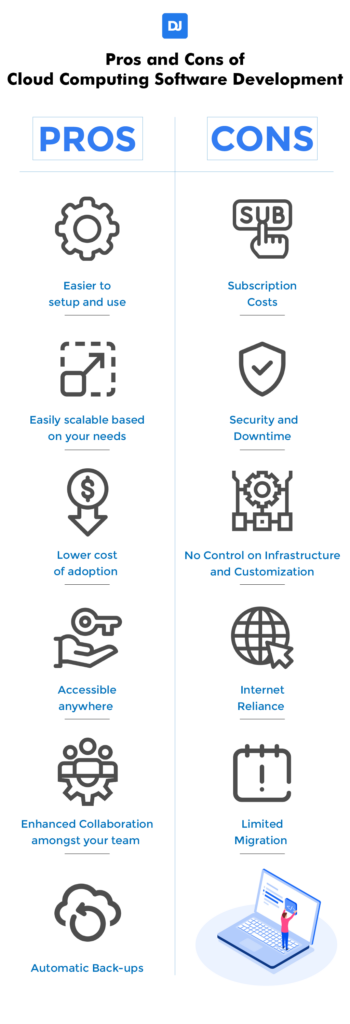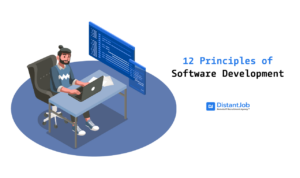Software development is becoming increasingly flexible when it comes to team management, collaboration, and location. As a consequence, companies have begun to look for platforms that move away from traditional on-site solutions.
Cloud Software development is the answer to these demands, but also other problems modern companies face when they need to set up their infrastructure. It has become a popular way for companies to deal with their server needs.
Let’s go over the benefits and things to look out for if you want or plan to incorporate cloud based software development in your company.
Cloud Software Development: Overview
Cloud computing provides services of data storage and computing power to other machines to increase their processing power and storage capabilities without individually investing in new or additional hardware. When we refer to “the cloud”, we’re talking about the whole infrastructure of machinery, servers and networking that provide these services.
Given this explanation, what is cloud development? It’s when you apply the principles of cloud computing to creating software. With cloud development, you establish an ecosystem where you can use production and development tools, and even run server-based applications, all from the cloud and without needing to install anything on your machine. This means you can use complex applications much more freely, without heavy hardware requirements on the user’s end.
Service Models
Cloud computing has three common types of services it can provide (with decreasing control over the cloud infrastructure by the user of the service):
- Infrastructure as a Service (IaaS): Provides access to servers, storage and networks, allowing the user to run any software they deem fit.
- Platform as a Service (PaaS): Provides access to machine(s) within the cloud that come pre-installed with a specific type of operative system.
- Software as a Service (SaaS): Provides access to specific software and applications running on the cloud infrastructure.
Deployment Models
Depending on the needs of the cloud user, there are several ways to deploy a Cloud Computing service. Each brings advantages and disadvantages, and the choice of which to pick will usually boil down to budget available, need for privacy and the number of users.
The most common types Deployment models are as follows (with increasing user access):
- Private Cloud: A cloud infrastructure deployed either internally or externally for the use of a single organization or company.
- Community Cloud: A cloud infrastructure usually deployed for the exclusive use of a number of organizations with similar fields of work or needs.
- Hybrid Cloud: A mix between Private and Public cloud. Usually deployed when you need services to interact with clients, but their data is sensitive and must be maintained in a secure manner.
- Public Cloud: A cloud infrastructure deployed for the internet at large, where multiple users can access the provided service at once.
Pros and Cons of Cloud Computing in Software Development
Cloud computing streamlines software development considerably by offloading a lot of the responsibilities from the development team.

Advantages of Cloud Computing in Software Development:
1. Easier to setup and use
The cloud is all about using a server structure but not being bogged down with the details of its implementation. By letting a third party manage a cloud infrastructure for you, you and your team reap the benefits of using it without having to worry about how to setup or maintain it.
This also means you and your team can get instant access to the software you need without having to worry about hardware specifications.
2. Easily scalable based on your needs
Services that provide cloud services will allow you to scale how many machines and processing power you can use at any time, making it an extremely flexible service.
This has the side benefit of also providing you with virtually any amount of storage space required for your team’s operational needs.
3. Lower cost of adoption
Being scalable brings a secondary advantage with it. Most of the cloud services on offer use a pay-as-you-go system, where the costs of using the cloud are reflected on the needs of the customer. This makes the initial adoption of a cloud service far simpler and budget-friendly, since there is no need to pay for physical hardware or any dedicated personnel to deal with the cloud infrastructure.
4. Accessible anywhere
At the end of the day the cloud is an internet-based service, which allows developers to use and take advantage of it no matter where they are. If they have a computer with minimum specs and access to the internet, any member of the team will be able to get to the cloud and be ready to work.
5. Enhanced Collaboration amongst your team
By letting your dev team have access to a central point for development, you enhance their ability to cooperate and work on projects together in real-time. This also gives the side benefit of anyone in your team having instant access to the most recent versions of anything the team is working on.
6. Automatic Back-ups
Companies that provide cloud services will usually perform routine back-ups of all the data stored in the cloud. This frees up your team from doing and managing it themselves and puts them at ease by creating more redundancy of their work.
But no service ever brings only advantages, and cloud computing is no exception. By choosing Cloud Computing for your software development cycle, be aware that it has its drawbacks.
Disadvantages of Cloud Computing Software Development
1. Subscription Costs
Although the initial cost of setting up a cloud is far lower than setting up a server yourself, continued use of a cloud platform is not without its share of costs. Be sure you are prepared to deal with a subscription that can potentially rise as the needs of your team demand more from your cloud service of choice.
2. Security and Downtime
Any cloud service has the potential risk of breaches and leaks. Also the services can physically fail, which translates to downtime on the customer’s end. Although these failures are very infrequent, they still happen even to the most secure or stable systems.
- There is an upside to using an established service in this case: The companies offering these services also have experience with providing security and stability for these systems, and are more likely to have the resources, technology stacks and personnel to set up a stronger and more secure platform than anyone starting from scratch.
3. Loss of Control over the Infrastructure and Customization
These services are provided off-premises, and thus you lose the ability to control the hardware and (depending on the service) the software you can use. If you have specific needs in your development cycle, take care when choosing an appropriate cloud-based platform that can fulfil them.
4. Internet Reliance
Cloud services are extremely flexible and powerful, but all of that means nothing if your team has limited or inexistent access to the internet. Make sure your company and its employees have good internet access before committing to a cloud solution, or you’ll risk not being able to use it properly.
Also remember that by making local back-ups of your cloud’s data, depending on the quantity of data being transferred, you can potentially throttle your internet connection. Be especially careful if your bandwidth is on the slower side.
5. Limited Migration
By committing to a cloud solution, you are essentially transferring your data to a third party. This can be detrimental when you want to change your provider:
- It can potentially expose your information: By allowing your data to circulate on the internet, there are more points of failure where hackers and other bad-faith actors can access it. This risk is doubled if you want to create a backup from one service and then upload it to another.
- Your cloud’s storage size can grow more than you can locally store: Cloud services are very good when it comes to abstracting your storage space, and make it easy to store your data without worrying about hardware limitations. However, huge data sizes make it harder to create local back-ups, since you’ll need to replicate the hardware in terms of storage size to create a local back-up. Depending on the size of your data this can be more or less feasible to do, both in terms of physical space and costs.
Keep this in mind when you are choosing a service and make sure it can accommodate your needs in the long run. Or, failing that, make sure your service of choice can provide a safe option to transfer your data in case you need to migrate at any point.
Conclusion
Cloud services are extremely flexible and powerful, allowing you to offload many costs and operational headaches over to established companies that have experts in the field. You trade fine control over your systems and applications for wider availability and scalable costs and power.
With the internet’s growth in the last couple of decades, cloud solutions are becoming ever more prevalent. From business solutions such as Oracle Cloud Applications and Shopify to more personal solutions such as file hosting services like Google Drive or Dropbox, cloud-based applications are here to stay.
If you’re looking to hire remote developers skilled to develop your cloud-based applications, DistantJob’s experts can provide you with the right people for your company that can cover any need you have.




